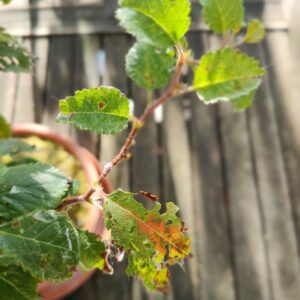Let’s observe nature: in autumn there are trees that lose their leaves, for example trees which belong to the deciduous species. In that case we do not have to be worried, we just need to enjoy the coloring of the foliage and the branching, waiting for the spring.
Furthermore, even the evergreens in late summer allow the innermost needles (or leaves) to dry (typically from previous years) and this shouldn’t scare us.
However, if we are not in this situation, we can evaluate well what is happening, above all we observe if there are insects of every color (or “dots” of every color) above and below the leaf pages or on the trunk. Let’s keep in mind where the “sick” leaves are concentrated and what they look like. Here are the most common observations:
- A few leaves concentrated inside the foliage turn yellow / fall, no insects are noticed. It is possible that the bonsai is suffering from incorrect watering, lack of light (even only in that diseased area) or fertilizer. The plant in difficulty sacrifices the most shaded and weak leaves, that is, those that give less energy and the same can happen with some twigs. In this case, we move the bonsai to a brighter place, we water only when the earth is dry, we give small doses of microelements. Let’s evaluate if we can prune the largest and most vigorous branches that take away energy and light from the smaller internal ones (but which are more useful for a bonsai).
- Some leaves exposed to strong sunlight show dry patches in the center or at the tip, no insects are noticeable, the leaves do not fall immediately. It is possible that the bonsai is suffering from too much heat, or that it has sunburned. In which case, let’s move it to the shade and spray the leaves every morning.
- The leaves have a yellowing in the background with evident green veins, no insects are noticeable. It is possible that the bonsai is suffering from iron chlorosis, which occurs when the soil is now poor in nutrients, not very acidic and full of limestone. This may be due to the fact that we wet more than necessary and used aqueduct water rich in limestone and chlorine. We have probably not repotted the plant for many years (the earth is now exhausted and compact). First of all we try to wet the bonsai in the morning and only when the soil is completely dry. It is possible to intervene by fertilizing with microelements of organic origin (including chelated iron) and slow release organic fertilizer (absolutely non-chemical). To prevent the problem we try to collect and use rainwater; or we leave the tap water for at least 24 hours to decant in a watering can. Finally, it is advisable to repot the plant as soon as the period allows (spring or early autumn).
- The leaves turn yellow or wither, they still fall green … there are white or black molds … and no insects are noticed. It is possible that the plant is suffering from a fungus (the most common are powdery mildew, scab, rust, downy mildew, smokiness …) perhaps due to the fact that we have wet / fertilized too much, or too little: the result is that we are doing rot roots. Let’s shelter the bonsai from the strongest rays of the sun, let’s focus on watering, trying to wet only when the soil is completely dry. We do not fertilize and we do not nebulize. Instead, we sprinkle the foliage with a broad spectrum and lightly dosed fungicide product. We water with solutions of organic microelements. Finally, it is advisable to repot the plant as soon as the period allows (spring or early autumn) by increasing the volume of the draining earth (eg adding pumice).
- The leaves turn yellow or dry up, they are “eaten”, you notice insects and / or ants above and below the leaf page or on the branches, we also see sticky molasses. It is possible that the plant is suffering from parasites such as mites (spider mites), aphids (lice), scale insects, caterpillars … which often hide on the underside of the leaves. In general, it is advisable to shower the foliage (above and especially on the underside of the leaves, as well as on the trunk). We eliminate the insects that we can remove on sight with absorbent paper (soaked in alcohol) such as caterpillars or large scale insects. Then we can spray the foliage with a broad spectrum insecticide product with a light dosage, or insert some insecticide tablets into the ground. We keep the plant away from strong sunlight and check its health (and insects) every day. We water with solutions of organic microelements and nebulize the foliage. As a prevention, to suffocate eggs and larvae, at the end of winter it is suggested to spray the still bare deciduous trees with “white mineral oil” diluted in water.
Was this article good for you? You can leave a comment or ask a question (Posting will be subject to approval)

